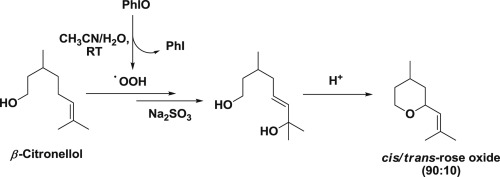Journal of Cleaner Production ( IF 9.7 ) Pub Date : 2017-12-05 , DOI: 10.1016/j.jclepro.2017.12.016 Pratibha Dwivedi , Mangat Singh , Umesh Singh , Surendra Jatav , Rajender S. Sangwan , Bhuwan B. Mishra

|
Rose oxide occupies top rank among the volatiles of high olfactory significance. Naturally it occurs as a minor but precious constituent of essential oils obtained from Rosa damascene and Pelargonium spp. High cost and limited availability of natural rose oxide restricts its pervasive application in high-value perfumes. Therefore, synthetic rose oxide is produced on a much larger scale as a mixture of the four (−)-cis-, (+)-cis-, (−)-trans-, and (−)-trans-stereoisomers, having aroma profile similar to naturally occurring rose oxide. However, the methods reported in literature for preparation of synthetic rose oxide involve harsh reaction condition, use of toxic metals salts and non-renewable chemicals and solvents.
This paper discusses a novel, convenient, safe, scalable and cost effective process for manufacturing rose-oxide stereoisomers, predominantly the cis-rose oxide (∼90%) via radical peroxidation of β-citronellol using hypervalent iodine reagent iodosylbenzene (PhIO) at ambient temperature. The methodology provides an alternative to conventional process of rose oxide production via photooxidation of β-citronellol. A safe processing of β-citronellol to rose oxide could be achieved by working in a mixture of acetonitrile-water as solvent system at ambient temperature in the absence of any additive or catalyst. The product cis/trans-rose oxide (∼90:10) could be obtained in high purity through direct distillation from the reaction mixture followed by detection and quantification using GC-MS analysis.
Despite significant advances in process designing and operation, the yields of essential oil obtained from Pelargonium spp. could not be enhanced significantly to affect its price and availability for creating rosy notes of commercial importance. Therefore, a semi-synthetic production of a compositional mimic oil of Pelargonium spp. from volatile oil of citronella (Cymbopogon winterianus), would be promising in catering to the demand for such an aroma oil. Thus, developed methodology of rose oxide production from β-citronellol was successfully applied for an in situ rose oxide olfactory value addition to low value citronella essential oil to obtain a compositional mimic oil of rose scented geranium, thereby provides newer opportunities of products, flavors and additives.
中文翻译:

碘代苯(PhIO)介导的β-香茅醇合成玫瑰氧化物及其在原位富集玫瑰氧化物中的应用导致香茅精油的增值
氧化玫瑰在具有高嗅觉意义的挥发物中排名最高。自然地,它是从玫瑰果和天竺葵属植物中获得的精油的次要但珍贵成分。天然玫瑰氧化物的高成本和有限的可用性限制了其在高价值香水中的广泛应用。因此,合成的氧化玫瑰以四个(-)-顺-,(+)-顺-,(-)-反-和(-)-反的混合物的形式大规模生产-立体异构体,具有类似于天然存在的氧化玫瑰的香气特征。然而,文献中报道的用于制备合成玫瑰氧化物的方法涉及苛刻的反应条件,使用有毒金属盐以及不可再生的化学品和溶剂。
本文讨论了一种新颖,便捷,安全,可扩展且具有成本效益的方法,用于生产玫瑰氧化物立体异构体,主要是在环境温度下使用高价碘试剂碘基苯(PhIO)通过β-香茅醇的自由基过氧化来制造顺式氧化玫瑰(〜90%)。温度。该方法为通过β-香茅醇的光氧化生产玫瑰氧化物的常规方法提供了一种替代方法。通过在环境温度下,在无任何添加剂或催化剂的情况下,在乙腈-水的混合物中作为溶剂体系,可以安全地将β-香茅酚加工成氧化玫瑰。产品顺/反通过从反应混合物中直接蒸馏,然后使用GC-MS分析进行检测和定量,可以得到高纯度的氧化玫瑰(约90:10)。
尽管工艺设计和操作方面取得了重大进步,但从天竺葵属植物中获得的香精油收率却很高。不能显着增强它的价格和可用性,以产生具有商业重要性的玫瑰色香调。因此,天竺葵属的组成模拟油的半合成产物。香茅(Cymbopogon winterianus)挥发油中的油,有望满足这种香精油的需求。因此,成功开发了从β-香茅醇生产玫瑰氧化物的方法,并成功地应用于原位 在低价值的香茅精油中添加玫瑰氧化物的嗅觉价值,以获得玫瑰香气的天竺葵成分模拟油,从而为产品,香精和添加剂提供新的机会。





















































 京公网安备 11010802027423号
京公网安备 11010802027423号